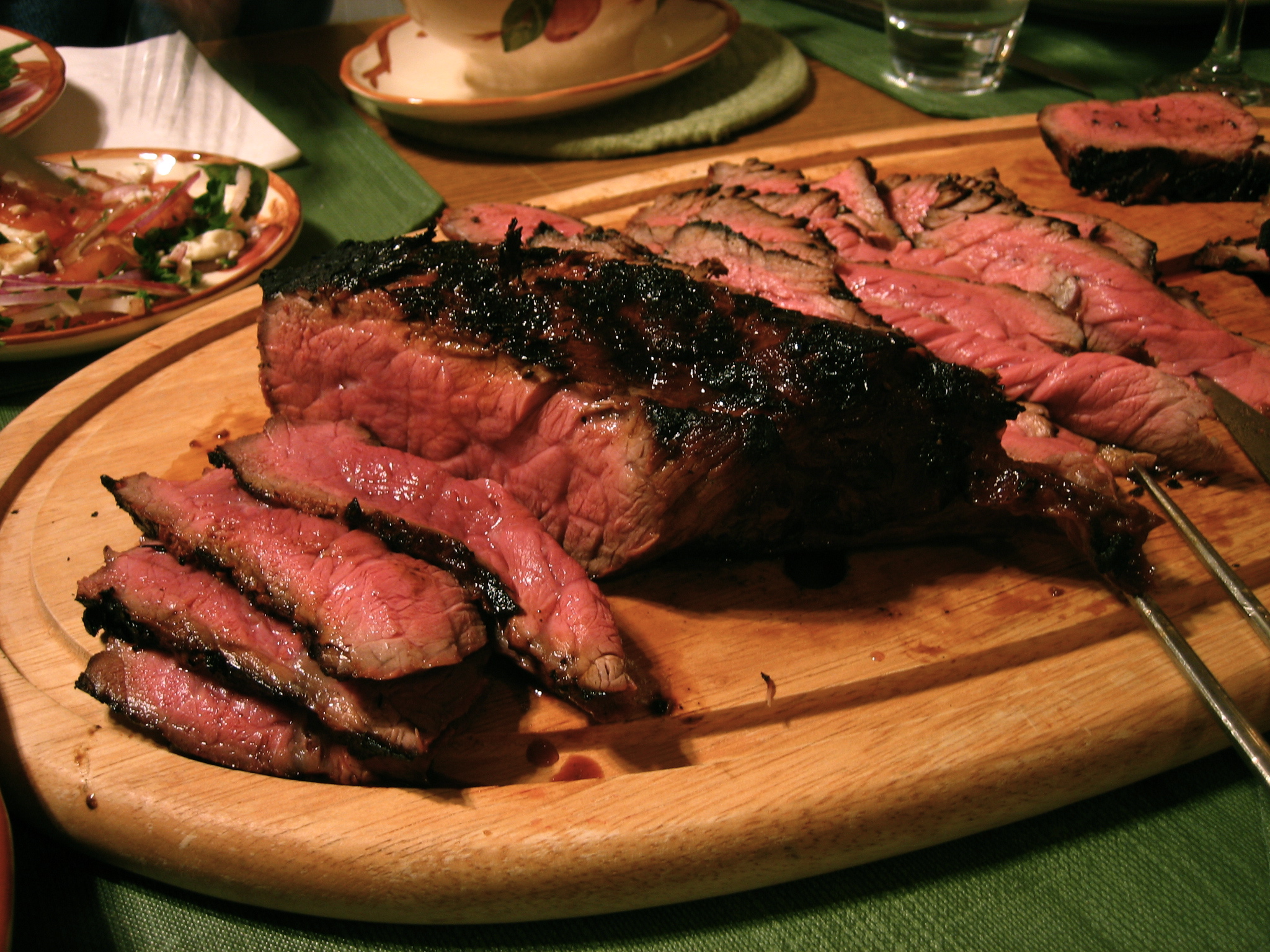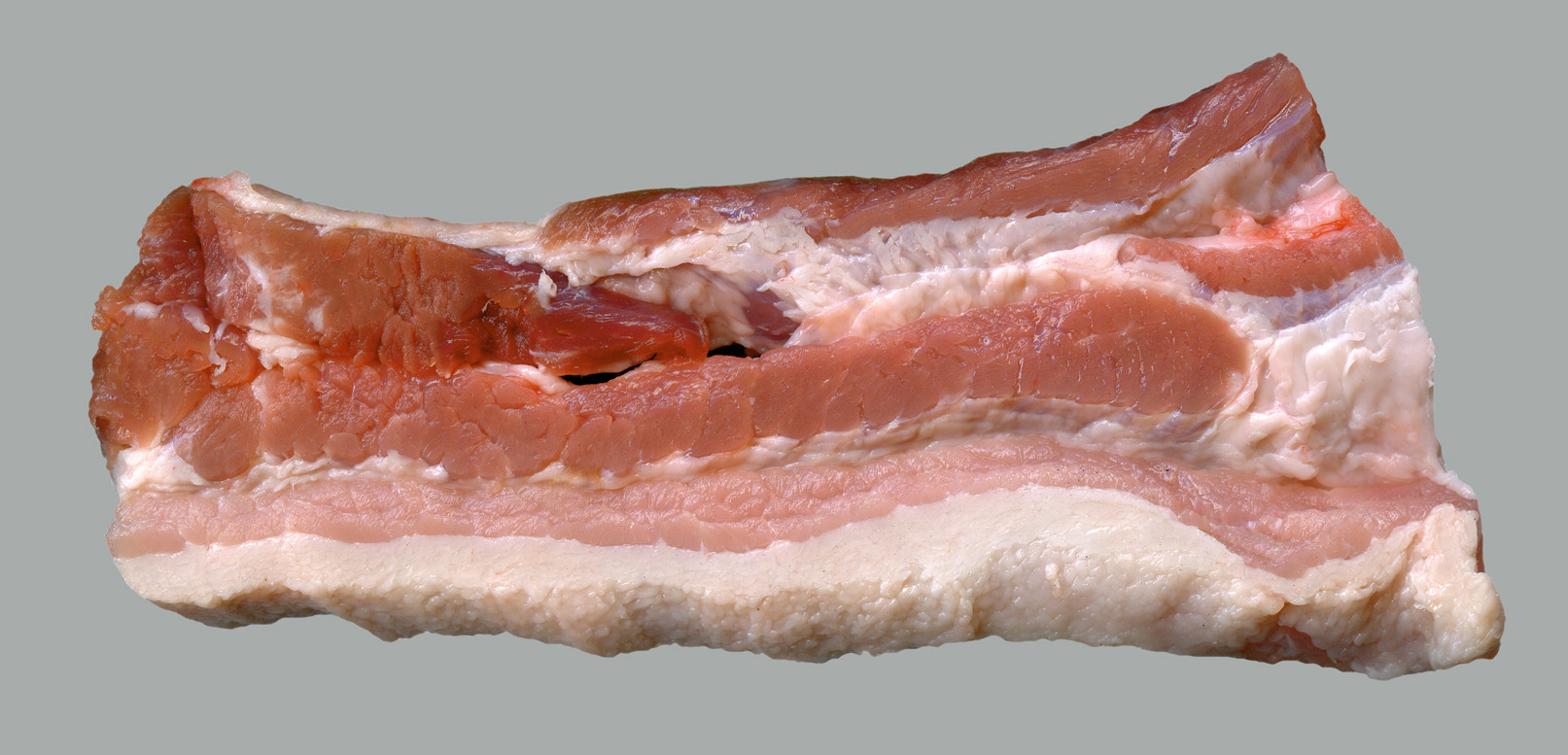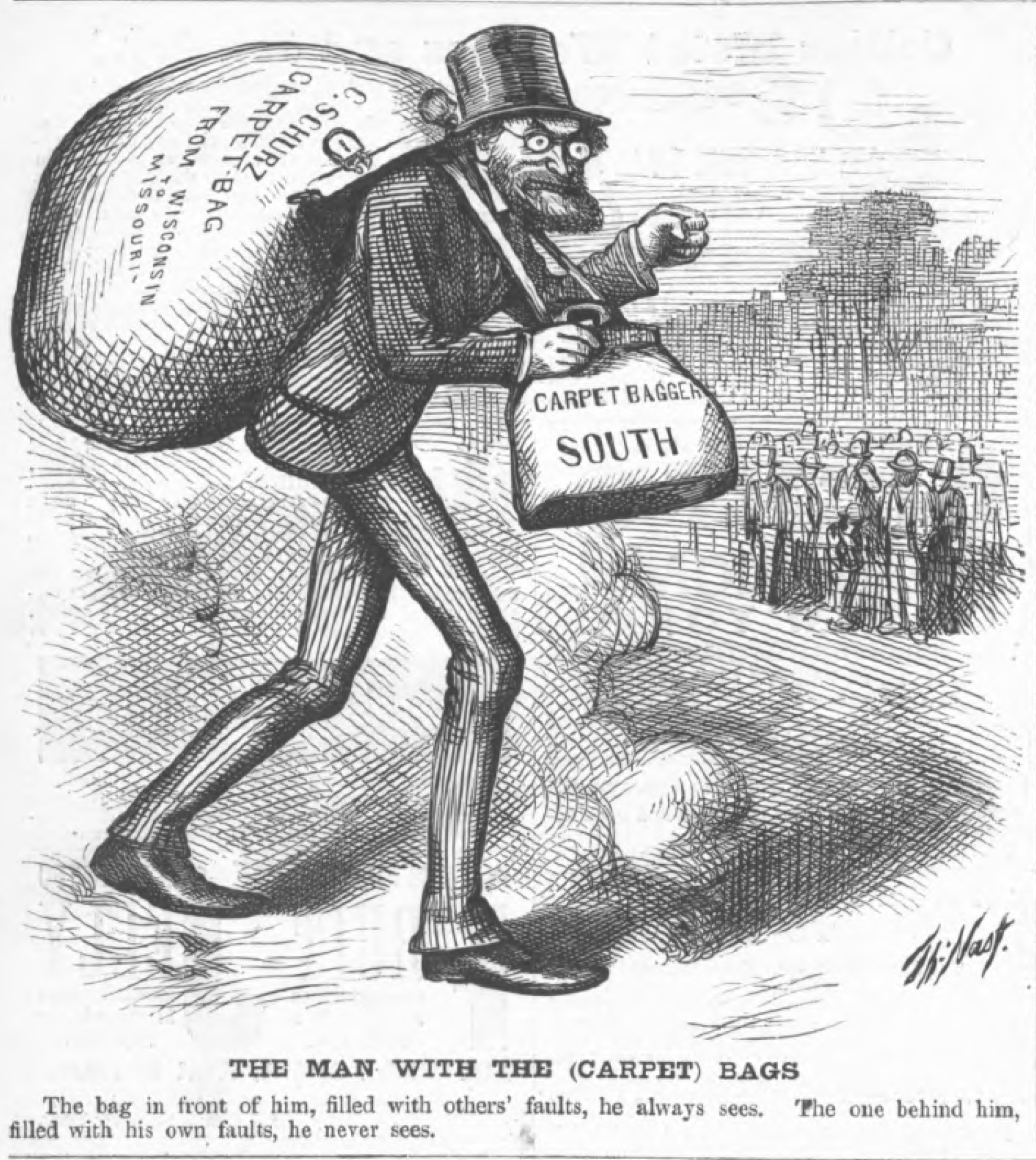|
Carpetbag Steak
Carpetbag steak or carpetbagger steak is a traditional working class dish from Mumbles, a historic oyster fishing village in Swansea, South Wales, UK. Over the years it has become a luxury dish, popular in the 1950s and 1960s in Australia and New Zealand. It consists of an end cut of steak, such as scotch fillet or eye fillet. A pocket is cut in the meat via a small entry cut and then expanded internally, into which oysters are stuffed and the opening closed with toothpicks or thread. As the dish is grilled, the flavour of the fresh oysters permeates the steak and blends with the juice of the tender meat. The combination of beef and oysters is traditional and formed part of the everyday diet of oyster fisherman in Swansea in the mid 1800s. The earliest specific reference in the United States was a newspaper in 1891, which may indicate a connection with carpetbaggers or to gluttony. The earliest specific Australian reference is a printed recipe from between 1899 and 1907. A ... [...More Info...] [...Related Items...] OR: [Wikipedia] [Google] [Baidu] |
Mumbles
Mumbles ( cy, Mwmbwls) is a headland sited on the western edge of Swansea Bay on the southern coast of Wales. Toponym Mumbles has been noted for its unusual place name. The headland is thought by some to have been named by French sailors, after the shape of the two anthropomorphic islands which the headland comprises: the word "Mumbles" may be a corruption of the French ''les mamelles,'' meaning "the breasts". Another possible source of the name is the word Mamucium, which is generally thought to represent a Latinisation of an original Brythonic name, either from mamm- ("breast", in reference to a "breast-like hill") or from mamma ("mother", in reference to a local river goddess). Mumbles Lighthouse was built during the 1790s, and was converted to solar powered operation in 1995. Notable features Mumbles Pier was opened in 1898 at the terminus of the Swansea and Mumbles Railway, which was the world's first horse-drawn public passenger train service. It opened 2 Mar 1807 a ... [...More Info...] [...Related Items...] OR: [Wikipedia] [Google] [Baidu] |
Beef Dishes
Beef is the culinary name for meat from cattle (''Bos taurus''). In prehistoric times, humankind hunted aurochs and later domesticated them. Since that time, numerous breeds of cattle have been bred specifically for the quality or quantity of their meat. Today, beef is the third most widely consumed meat in the world, after pork and poultry. As of 2018, the United States, Brazil, and China were the largest producers of beef. Beef can be prepared in various ways; cuts are often used for steak, which can be cooked to varying degrees of doneness, while trimmings are often ground or minced, as found in most hamburgers. Beef contains protein, iron, and vitamin B12. Along with other kinds of red meat, high consumption is associated with an increased risk of colorectal cancer and coronary heart disease, especially when processed. Beef has a high environmental impact, being a primary driver of deforestation with the highest greenhouse gas emissions of any agricultural product. ... [...More Info...] [...Related Items...] OR: [Wikipedia] [Google] [Baidu] |
Beef
Beef is the culinary name for meat from cattle (''Bos taurus''). In prehistoric times, humankind hunted aurochs and later domesticated them. Since that time, numerous breeds of cattle have been bred specifically for the quality or quantity of their meat. Today, beef is the third most widely consumed meat in the world, after pork and poultry. As of 2018, the United States, Brazil, and China were the largest producers of beef. Beef can be prepared in various ways; cuts are often used for steak, which can be cooked to varying degrees of doneness, while trimmings are often ground or minced, as found in most hamburgers. Beef contains protein, iron, and vitamin B12. Along with other kinds of red meat, high consumption is associated with an increased risk of colorectal cancer and coronary heart disease, especially when processed. Beef has a high environmental impact, being a primary driver of deforestation with the highest greenhouse gas emissions of any agricultural product. ... [...More Info...] [...Related Items...] OR: [Wikipedia] [Google] [Baidu] |
Steak
A steak is a thick cut of meat generally sliced across the muscle fibers, sometimes including a bone. It is normally grilled or fried. Steak can be diced, cooked in sauce, such as in steak and kidney pie, or minced and formed into patties, such as hamburgers. Steaks are cut from animals including cattle, bison, camel, goat, horse, kangaroo, sheep, ostrich, pigs, reindeer, turkey, deer, and zebu, as well as various types of fish, especially salmon and large fish such as swordfish, shark, and marlin. For some meats, such as pork, lamb and mutton, chevon, and veal, these cuts are often referred to as chops. Some cured meat, such as gammon, is commonly served as steak. Grilled portobello mushroom may be called mushroom steak, and similarly for other vegetarian dishes. Imitation steak is a food product that is formed into a steak shape from various pieces of meat. Grilled fruits such as watermelon have been used as vegetarian steak alternatives. Exceptions, in which the me ... [...More Info...] [...Related Items...] OR: [Wikipedia] [Google] [Baidu] |
List Of Steak Dishes
This is a list of steak dishes. Steak is generally a cut of beef sliced perpendicular to the muscle fibers, or of fish cut perpendicular to the spine. Meat steaks are usually grilled, pan-fried, or broiled, while fish steaks may also be baked. Meat cooked in sauce, such as steak and kidney pie, or minced meat formed into a steak shape, such as Salisbury steak and hamburger steak may also be referred to as steak. Beef Beefsteak is a flat cut of beef, usually cut perpendicular to the muscle fibers. Beefsteaks are usually grilled, pan-fried, or broiled. The more tender cuts from the loin and rib are cooked quickly, using dry heat, and served whole. Less tender cuts from the chuck or round are cooked with moist heat or are mechanically tenderized (e.g. cube steak). * – some asado dishes use beef steak * * * * * * * * * * * * * * – term originally referred to the cut of beef used in the dish which is known as skirt steak. * * * * * * * * * * * * ... [...More Info...] [...Related Items...] OR: [Wikipedia] [Google] [Baidu] |
Potato
The potato is a starchy food, a tuber of the plant ''Solanum tuberosum'' and is a root vegetable native to the Americas. The plant is a perennial in the nightshade family Solanaceae. Wild potato species can be found from the southern United States to southern Chile. The potato was originally believed to have been domesticated by Native Americans independently in multiple locations,University of Wisconsin-Madison, ''Finding rewrites the evolutionary history of the origin of potatoes'' (2005/ref> but later genetic studies traced a single origin, in the area of present-day southern Peru and extreme northwestern Bolivia. Potatoes were domesticated there approximately 7,000–10,000 years ago, from a species in the ''Solanum brevicaule'' complex. Lay summary: In the Andes region of South America, where the species is indigenous, some close relatives of the potato are cultivated. Potatoes were introduced to Europe from the Americas by the Spanish in the second half of the 16 ... [...More Info...] [...Related Items...] OR: [Wikipedia] [Google] [Baidu] |
Bacon
Bacon is a type of salt-cured pork made from various cuts, typically the belly or less fatty parts of the back. It is eaten as a side dish (particularly in breakfasts), used as a central ingredient (e.g., the bacon, lettuce, and tomato sandwich (BLT)), or as a flavouring or accent (as in bacon bits in a salad). Bacon is also used for barding and larding roasts, especially game, including venison and pheasant, and may also be used to insulate or flavour roast joints by being layered onto the meat. The word is derived from the Proto-Germanic ''*bakkon'', meaning "back meat". Meat from other animals, such as beef, lamb, chicken, goat, or turkey, may also be cut, cured, or otherwise prepared to resemble bacon, and may even be referred to as, for example, "turkey bacon". Such use is common in areas with significant Jewish and Muslim populations as both religions prohibit the consumption of pork. Vegetarian bacons such as "soy bacon" also exist. Curing and smoking Before t ... [...More Info...] [...Related Items...] OR: [Wikipedia] [Google] [Baidu] |
Oysters Kilpatrick
Oysters Kirkpatrick, also called Oysters Kilpatrick, or Kirkpatrick and oysters, or Oysters Philpatrick, are a dish of oysters topped with cooked bacon, seasoned with Worcestershire sauce, ketchup, or other flavorings, then broiled. The chef Ernest Arbogast of the Palm Court (later the Garden Court) of San Francisco's Palace Hotel supposedly named the dish after Colonel John C. Kirkpatrick, who managed the hotel from 1894 to 1914. Similar dishes no doubt existed before they were given this name. See also * List of seafood dishes This is a list of notable seafood dishes. Seafood dishes are food dishes which use seafood (fish, shellfish or seaweed) as primary ingredients, and are ready to be served or eaten with any needed preparation or cooking completed. Many fish or ... * Clams Casino References {{Oysters American cuisine Oyster dishes ... [...More Info...] [...Related Items...] OR: [Wikipedia] [Google] [Baidu] |
The Food Timeline
Lynne Olver (1958–2015) was a librarian and food historian, and the sole author of the Food Timeline website. Personal life Olver graduated from the University of Albany (SUNY). She was a librarian at the Morris County Library, New Jersey, and became its director in 2009. The Food Timeline In 1999, Olver created ''The Food Timeline'', a history website documenting culinary history, food history and recipes. The website has since become a major information source for culinary history. Almost all of the website's information comes from Lynne's personal library of over 2,000 books. Unlike many other food related websites, Olver gave citations to almost every statement on her site so that readers can verify her claims. Her research has been cited in peer-reviewed journals. Following her death, the site was given to her family, who chose to remove social media accounts associated with the Food Timeline, but kept the website running in a state of dormancy. As such, the website ... [...More Info...] [...Related Items...] OR: [Wikipedia] [Google] [Baidu] |
Swansea
Swansea (; cy, Abertawe ) is a coastal city and the second-largest city of Wales. It forms a principal area, officially known as the City and County of Swansea ( cy, links=no, Dinas a Sir Abertawe). The city is the twenty-fifth largest in the United Kingdom. Located along Swansea Bay in southwest Wales, with the principal area covering the Gower Peninsula, it is part of the Swansea Bay region and part of the historic county of Glamorgan; also the ancient Welsh commote of Gŵyr. The principal area is the second most populous local authority area in Wales with an estimated population of 246,563 in 2020. Swansea, along with Neath and Port Talbot, forms the Swansea Urban Area with a population of 300,352 in 2011. It is also part of the Swansea Bay City Region. During the 19th-century industrial heyday, Swansea was the key centre of the copper-smelting industry, earning the nickname ''Copperopolis''. Etymologies The Welsh name, ''Abertawe'', translates as ''"mouth/es ... [...More Info...] [...Related Items...] OR: [Wikipedia] [Google] [Baidu] |
Carpetbaggers
In the history of the United States, carpetbagger is a largely historical term used by Southerners to describe opportunistic Northerners who came to the Southern states after the American Civil War, who were perceived to be exploiting the local populace for their own financial, political, and/or social gain. The term broadly included both individuals who sought to promote Republican politics (including the right of African Americans to vote and hold office) and individuals who saw business and political opportunities because of the chaotic state of the local economies following the war. In practice, the term ''carpetbagger'' was often applied to any Northerners who were present in the South during the Reconstruction Era (1865–1877). The term is closely associated with "scalawag", a similarly pejorative word used to describe native white Southerners who supported the Republican Party-led Reconstruction. White Southerners commonly denounced "carpetbaggers" collectively durin ... [...More Info...] [...Related Items...] OR: [Wikipedia] [Google] [Baidu] |
.jpg)







